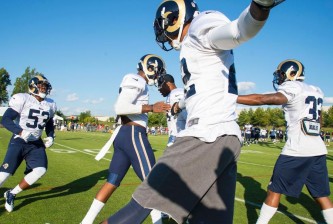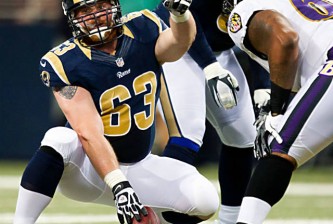
Ray Rice averaged 12.5 yards per touch, with the Rams’ defensive gameplan focused on stopping him. Imagine if they hadn’t…
I confess that I have not gone back and looked at the game tape from Sunday’s massacre at the hands of the Baltimore Ravens. Given the improved talent level of this team, and the strides the team made last year, I can’t help but believe that the Rams’ problems are fixable. Further game analysis will give us clues, but a look at the numbers shows us several key indicators that must turn around for this season to turn around.
#1: The Rams defense has to get off the field.
No team’s defense has been on the field for more plays than the Rams. At 214 total plays, we are averaging more than 70 plays per game. They looked gassed against the Eagles at roughly the 50-play count, and had the Ravens taking shots down the field late in the game. Our defense is in the bottom 25% of the league in yards per play, third down efficiency, time of possession per game, and of course, points allowed. This isn’t a knock on the run or the pass defense, it has all been bad.
More concerning is the suddenly advanced age of the defense. Several veteran additions to the Rams defense have not gelled, particularly in the linebacking corps, which saw a lot of turnover. At this point, Brady Poppinga and Ben Leber are not showing themselves to be an upgrade over Na’il Diggs and Bryan Kehl, which is saying something. Fred Robbins’ fountain of youth appears to have run out, and both he and Justin Bannan are negatively rated by Pro Football Focus. Al Harris is a part timer at best, and could not be brought in to give the struggling Justin King even a series of relief in the starting role.
Spagnuolo’s defense last year, younger and hungrier though less talented top to bottom, did a better job of flowing to the ball as a single unit. So far, the talent upgrade has torn apart our schematic chemistry. This can be fixed, and it must.
#2: The Rams need to take advantage of what their offensive line does well.
Here’s a funny dichotomy: the Rams are a top-ten NFL team (7th, actually) in yards per run play. But with only 71 running plays, we rank 25th in the league in likelihood of actually running the ball. Only the Eagles have a bigger disparity (58 runs, 4.8 yards per play) in their commitment to the run and the success of the run game.
Sam Bradford has already shown that the play-action can be a deadly weapon for him in the passing game. But our run game — even with Steven Jackson limited — is more valuable than just as a decoy to set up those play-action throws. The fact that we were successful running the ball even against the stout front lines of the Ravens and Giants show that this is no mirage.
While the offensive line has not played well overall, the signing of Harvey Dahl to replace Adam Goldberg had at least one expected positive result: the Rams’ interior run blocking has improved leaps and bounds from last year. An increased commitment to the run will only help them generate positive plays, and has the side benefit of keeping Bradford upright.
#3: More downfield passes, and more pace, please.
Rams fans have been asking for this for a while now. But now that Josh McDaniels has actually given us a taste of how good this offense can be down the field, we want more. Even with a much-maligned group of receivers that has been struggling with drops, Bradford is positively rated in all zones of the field — except for whatever reason, intermediate throws to the left side as our Week 2 passing chart shows.
Even with an increased commitment to the run, we don’t need 14-play drives to get us into position for a disheartening field goal, like we have in years past. This offense should be able to attack defenses high and low, but for whatever reason, just did not do that last week. (The offense’s complete blind spot when it came to identifying and blocking Terrell Suggs had something to do with that.)
Week 2’s offensive gameplan against New York was successful in every way but the scoreboard, with three of five drives into scoring position ending with a Josh Brown kick. In this week’s column, Tony Softli wrote about how much more energized Bradford appeared in that gameplan. Even with the talent we have, this offense should be capable of 24 points a game, easy. If we can get four to five scoring drives from this offense on a regular basis, the touchdowns and points will come, and so will the wins.






















